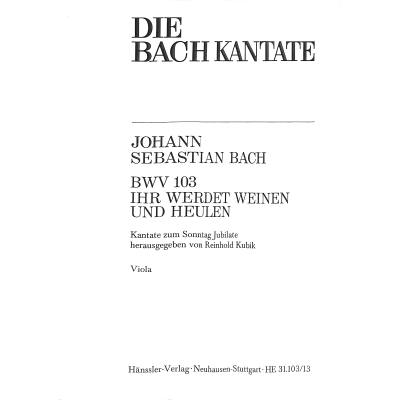Cantata No. 103: Ihr werdet weinen und heulen, BWV103
Contents:
Ihr werdet weinen und heulen BWV , is a cantata by Johann Sebastian Bach, a church cantata for the third Sunday after Easter, called Jubilate (Jubilate. BWV - "Ihr werdet weinen und heulen". Cantata for Jubilate. 1. Chor und Arioso B Ihr werdet weinen und heulen, aber die Welt wird sich freuen. - Ihr aber .
Recitative T Who would not collapse in lamentation, when our beloved is torn from us? The soul's salvation, the remedy for ailing hearts does not take heed of our pains. Du suchest ja nicht mein Verderben, Wohlan, so hofft mein Herze noch. Aria A Besides You is no doctor to be found, though I search throughout Gilead; who shall heal the wounds of my sins, since there is no balsam here?
If You conceal Yourself, I must die.
Navigation menu
Have mercy, ah, hear me! Indeed You do not seek my destruction, therefore my heart will still hope. Recitative A After my anxiety You will revive me again; therefore I will devote myself to Your return, I trust in the word of promise, that my sorrow shall be changed into joy.
The third movement is an aria in the form of a trio sonata for alto soloist with solo violin and a piccolo playing in unison above a staccato e piano continuo. Part 1 Part 2 Part 3 Part 4 Part 5. Chorus and Arioso B You shall weep and wail, but the world will rejoice. Thore Brinkmann; Digital Editing: Amore traditore BWV
Wie wohl ist mir dadurch geschehen, Nimm, nimm mein Herz zum Opfer an! Aria T Take hold of yourselves, troubled minds, you do yourselves too much injury. Give up the sorrowful course; before I collapse in tears, my Jesus will be seen again, O joy unlike any other! What well-being has found me through this; take, take my heart as an offering!
In his second year in Leipzig, Bach composed chorale cantatas between the first Sunday after Trinity and Palm Sunday , but for Easter he returned to cantatas on more varied texts, possibly because he lost his librettist. Bach edited her writing considerably, for example in movement 4, excising two lines of four and rephrasing the others. Bach first performed the cantata on 22 April with the Thomanerchor.
- Bach Cantata Translations?
- Bounded and Compact Integral Operators (Mathematics and Its Applications);
- Cantata No. 103, "Ihr werdet weinen und heulen," BWV 103 (BC A69)?
- TNM-Atlas: Illustrierter Leitfaden zur TNM/pTNM-Klassifikation maligner Tumoren (German Edition).
- Emmanuel Music - Bach Cantata BWV - Translation?
- Villains - Foster;
- .
For later performances, he revised the instrumentation, replacing the flauto piccolo by a flauto traverso. The cantata in six movements is scored for three vocal soloists alto , tenor and bass , a four-part choir , trumpet , flauto piccolo descant recorder in D , two oboes d'amore , two violins , viola and continuo.
The Internet's Premier Classical Music Source
The cantata begins in B minor , illustrating sorrow, but in movement 4 shifts to the relative major key of D major , illustrating the theme of consolation in Ziegler's text. The opening chorus has an unusual structure, which includes an arioso passage for the bass voice. All instruments except the trumpet play a ritornello , after which a choral fugue pictures the weeping and wailing of the text in unrelated musical material, rich in chromaticism.
In great contrast the following line, " aber die Welt wird sich freuen " But the world will rejoice , [1] is conveyed by the chorus embedded in a repeat of the first part of the ritornello.
The sequence is repeated on a larger scale: The bass as the vox Christi voice of Christ sings three times, with a sudden tempo change to adagio , " Ihr aber werdet traurig sein " But you will be sad [1] as an accompagnato recitative. Musicologist Julian Mincham notes: Bach's lack of respect for the conservative Leipzig authorities' dislike of operatic styles in religious music was never more apparent!
John Eliot Gardiner , who conducted the Bach Cantata Pilgrimage with the Monteverdi Choir in , notes that Bach's "strategy is to superimpose these opposite moods, binding them in a mutually enlightening whole and emphasising that it is the same God who both dispenses and then ameliorates these conditions.
- The World of Tennessee Williams.
- United Nations Sanctions and the Rule of Law (Cambridge Studies in International and Comparative Law?
- .
- !
- CCNP Security Firewall 642-617 Quick Reference?
- BRITISH INDIA AND THIRD GENERATION IMPERIALISM;
- .
Movement 2 is a secco recitative for tenor, concluding in an arioso section with a "deeply moving" melisma on the word " Schmerzen " sorrows. The sortable table are excerpt from the selection on the Bach Cantatas Website.

The type of choir and orchestra is roughly shown as a large group by red background, and as an ensemble with period instruments in historically informed performance by green background. From Wikipedia, the free encyclopedia. Bach Christiana Mariana von Ziegler , author of the cantata text.

Eva Fleischer Gert Lutze. Marie-Luise Gilles Kurt Equiluz.
Ihr werdet weinen und heulen, BWV 103 (Bach, Johann Sebastian)
Knabenchor Hannover Choir of King's College. Ruth Sandhoff Andreas Weller. Retrieved 15 April Retrieved 12 June